 |
||
|
||
| ||
Although Molex is quite a young company in CPU coolers field, its subdivision Thermal Acoustic Products is working in the sphere of cooling systems rather successfully producing mature (from the technical standpoint) coolers with their own peculiarities able to stand against old stagers of the thermal sector. Our tests prove that Molex keeps to its standards and, apart from the loud name, it offers a good balance of technical properties. So, today we will scrutinize the Molex's coolers in our strict and unbiased tests. The today's participants are coolers of the 37165 and 37256 series meant for processors for Socket A, - they are the Molex's basic coolers for the AMD platform. Let's see what features they offer. Key featuresThe 37165 series was set up over a year ago, but they keep on attracting computermen and computer assemblers thanks to their unusual futuristic appearance. 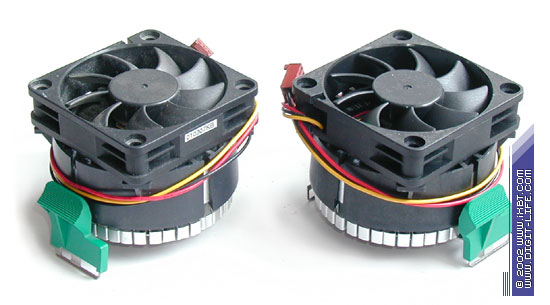 Molex 37165-0007 and 37165-0009 Coolers The first curious thing is a unique heatsink design based on the company's Radial Fin technology. It covers three technical ideas: a traditional rectangular finning is replaced with a radial one (external diameter 60 mm, height 25 mm) made of a folded aluminum tape (0.1 mm think), and a hollow copper core of 28 mm in diameter is used as a main heat-removing element. 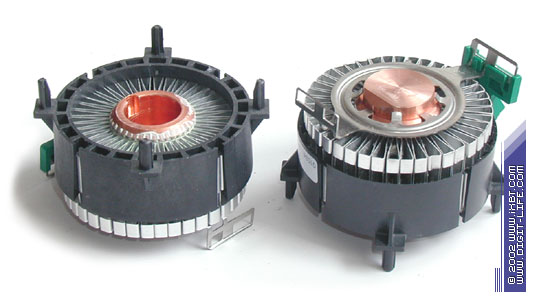 Design of the 37165 series The theory and the tests show that the radial fin design is a better match for a fan than standard rectangular heatsinks. If designed competently, it has a lower hydraulic resistance and effectively develops an air flow in the interfin channels without unnecessary turbulization (there is actually a continuous turbulent flow, i.e. the whole fin surface participates in heat exchanging). Moreover, such design has no dead zones typical of traditional coolers (area right under the central part of the cooler) where the flow speed is close to zero, and the heat exchange is much less effective because it works in conditions of free air convection. As a result, a well designed radial finning can show better efficiency than standard rectangular coolers in case of the same heat-exchange surfaces (or even smaller one of the radial cooler). The design of the heatsink in the 37165 model gives rise to no doubts regarding its technological correctness. The aluminum tape forms 40 wedge-shaped folds, and the overall heat-exchange surface reaches 850 cm2, which looks quite impressive for such a tiny heatsink. Such design allows for a stronger blow through the interfin channels, as well as for a good air flow around the external core surface making the heat removal from the core to the fins and then to the outer space more effective and reducing the entire thermal resistance of the cooler. The optimized aerodynamic properties of the folded finning of Molex are proved in the tests: the experiment carried out by our colleagues on the cooler of the 37104 series (which is just smaller and has a weaker fan compared to the 37165) shows quite a high flow rate in the interfin channels.  Left to right: design of the heatsinks of the 37104, 37167 and 37165 series The only downside in such construction is that the fins are attached to the core with thermal glue. Soldering would be a better choice, but it would also tell on the price, taking into account the unusual heatsink design for the standard production equipment. The developers had to comprimise. However, the thermo glue they used has rather good thermal conductivity, and the fins are covered with a tight external plastic jacket. Undoubtedly, this reduced the contact thermal resistance where the tape touches the core, and, according to Molex, it's not much greater than possible thermal resistance in case of soldered fins. The heat-removing core is made of copper, and, as you know, copper has better thermal conductivity than aluminum, that is why the copper core shows lower thermal resistance thus improving the overall thermal effectiveness of the cooler. Well, thanks to the elaborate design of the coolers of the 37165 series they show perfect thermal effectiveness being also very small. For example, the junior model named 37165-0007 and equipped with the fan measuring 60x60x15 mm and rotating at 3000 rpm is just a little bit inferior to the full-size Thermaltake Volcano 5 and Cooler Master DP5-6I31C, but it makes much less noise. The senior 37165-0012 equipped with the 5400 rpm fan is close on the heels of the famous Thermaltake Volcano 6Cu+, and its noise level is lower by 10 dBA; its effectiveness/noise ratio is almost equal to that of the Titan TTC-D5TB which is much bigger and more powerful. By the way, the coolers of the 37165 series reach such noise level not only because of the brand fans from Y.S. Tech (NFD126015) measuring 60x60x15 mm, but also thanks to the way they are attached to the heatsink. The fan is pressed to it not with bolts? - it sits on thin pins which are integrated into the external plastic heatsink's case. These pins serve as bracing and the plastic case as a support that damps possible vibrations of the fan while it rotates. As a result, the noise made by the 37165 models is purely acoustic (the cooler produces no structural vibrations in operation). The 37165 coolers are equipped with a very convenient mount that doesn't need a screw-driver and has a normal hold-down pressure (not more than 8 kg). Thanks to their decent dimensions and cylindrical shape the heatsinks of the 37165 model can top almost any Socket A mainboard. Absolutely all 37165 models have a preinstalled thermal interface. The coolers in the range from 37165-0007 to 37165-0009 (Molex positions them for Athlon) have the phase-change Thermagon T905C, and the models in the range from 37165-0010 to 37165-0012 (for Athlon XP) have the classical thermal grease Dow Corning 340. Now, when we have examined the 37165 coolers, let's move on to the new generation of Molex, - the series 37256. 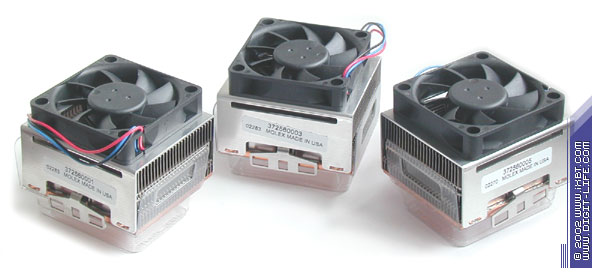 37256 series At first glance, the coolers of the series 37256 don't look like from Molex at all because of the simple copper-aluminum heatsink of 70x63x35 mm and an unsophisticated mount. The only thing that proves that the coolers belong to Molex is the sticker on the heatsink.  Left to right: Molex 37104-0007, 37165-0009, 37256-0003 coolers However, if you look closer, you will undoubtedly reveal more advantages. The strongest point of the 37256 series is the Stamped Fin technology Molex which was spent so much time on. Although these heatsinks look very similar to the solutions built on the old but good bonded fin technology (thin aluminum or copper fins soldered to the copper based are not rare today), their design has a very significant difference. In the bonded fin heatsinks the fins are simply soldered to the base's surface providing good thermal contact. In the stamped fin heatsinks the plates (0.3 mm thick) are stamped into the base and sewed to it with contact welding and surface soldering. 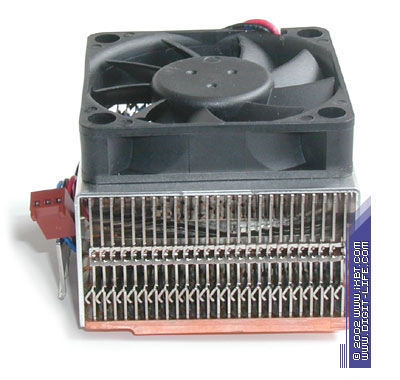
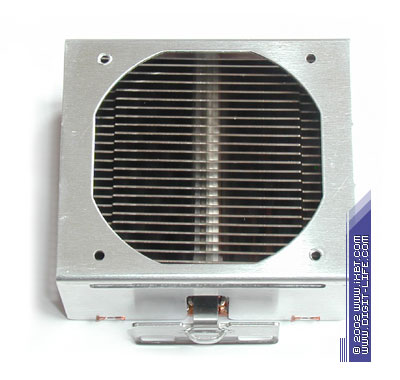 Design of the series 37256 According to Molex, it considereably improves quality of the thermal contact where the base is connected with the fins and markedly reduces the overall thermal resistance. As a result, the combined heatsinks of the series 37256 (copper base, aluminum fins) outshine the bonded-fin solutions in thermal effectiveness and catch up with the entirely copper bonded-fin models (or even solid copper skived-fin coolers). The coolers of the series 37256 showed excellent performance even despite their unattractive appearance and relatively weak fans of 60x60x13 mm. The junior model (37256-0001) equipped with a quiet low-power fan rotating at the speed of 3000 rpm goes on a par with the Thermaltake Volcano 5, Cooler Master DP5-6I31C and 37165-0009. The cooler that takes the middle position in the series (37256-0003) with the 4200 rpm fan competes successfully against the Titan TTC-D5T which is bigger and more powerful and outpaces the top cooler of the series 37165. The top model (37256-0005) coming with the cooler of 5400 rpm lags a bit behind the Thermaltake Volcano 7+ and Evercool CUD-725 but stands perfectly against the Cooler Master HCC-002 (copper bonded-fin heatsink, 60x60x25 mm, 6800 rpm) and Thermaltake Volcano 9 (mighty fan of 80x80x25 mm and 4000 rpm) and produces much less noise. That's very cool for the new-comers! ;-) 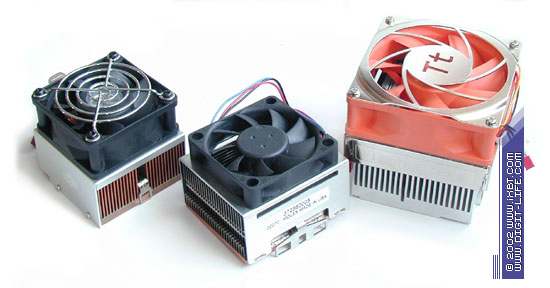 Left to right: Cooler Master HCC-002, Molex 37256-0005, Thermaltake Volcano 9 coolers The series 37256 has one more peculiarity concerning the fans. It incorporates hgih-quality fans AFB0612 from Delta Electronics which sport the proprietary mechanical construction. 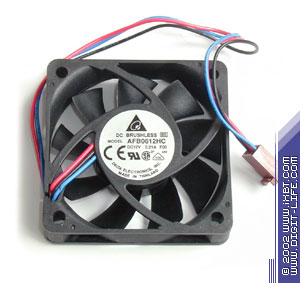
 Delta AFB0612HC fan with the insides In usual fans based on the combined bearings (ball bearing plus sleeve bearing) the load (the axle with impeller) is on both bearings, and the retaining washer is located behind the sleeve bearing. In the small fans from Delta the impeller's axle is shorter, and the retaining washer with a thin rubber gasket is placed between the ball bearing and the slide one. The fan becomes more reliable because the weaker sleeve bearing is almost unloaded and even in case of series damages it won't jam the impellar's axle. Such fan won't let you down. The installation of the coolers 37256 is even more convenient compared to the series 37165. Despite the tough mount that needs a screwdriver, it's a breeze to install the coolers: the fastening clip is fixed inside the heatsink (i.e. it doesn't move in course of the installation) and has a very handy hole for the screwdriver. 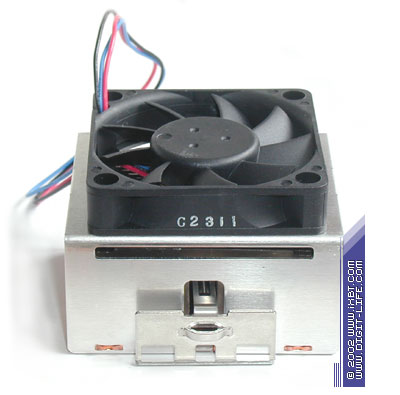 The dimensions of the coolers 37256 suit the AMD's requirements, that is why there will hardly be any compatibility problems with Socket A mainboards. All the models of the series 37256 are traditionally equipped with the thermal interface; in contrast to the 37165, here they use more effective thermo grease Shin Etsu G751. Besides, I must say that the heatsink base is excellently polished: Molex doesn't save on the electrochemical polishing. 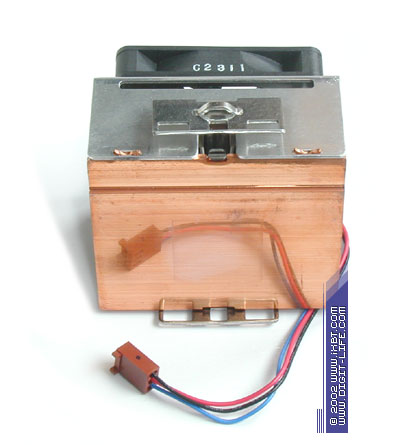 Now, when you have enough information on the design of the coolers of the Molex series 37165 and 37256, we proceed to the tests. TestsLet's start with the thermal effectiveness tested on our stands 1 and 2. Test stand 1:
Test stand 2:
The burnk7 from the CPUBurn packet was used for modeling the thermal load
close to the maximum, and the System Guard utility from Fijitsu Siemens Computers
for temperature control. Diagram 2. Thermal resistance, AMD Athlon XP 1800+ platform Diagram 3. Temperature, AMD Athlon XP 1800+ (Thoroughbred) platform Diagram 4. Thermal resistance, AMD Athlon XP 1800+ (Thoroughbred) platform Notes Now the noise characteristics of the tested coolers. Diagram 5. Noise characteristics Note ConclusionThe Molex coolers leave a very pleasant impression. With their high-quality advanced heatsinks, high-grade fans, a handy mount and a good combination of thermal and acoustic characteristics, they will definitely find supporters among computer enthusiasts and ordinary users interested in reliable and high-quality cooling systems. The series 37165 is not so popular as it used to be a year ago, but the Radial Fin coolers are still able to offer both attractive appearance and good performance characteristics. The junior models - 37165-0007 and 37165-0010 look most interesting, - they will be a good match for entry-level systems on the AMD Athlon XP showing acceptable thermal effectiveness and a low noise level. The series 37256 which incorporates new technological achievements suits for a wider range of systems starting from entry-level ones to high-performance AMD Athlon XP based computers. However, the junior solutions - 372560001-372560003 - show a more attractive effectiveness/noise ratio again, compared to the top models. The only disappointing factor is the price of the coolers 37165 and
37256. But taking into account the flexible price policy, I hope Molex
will soon improve the situation.
Vitaly Krinitsin (vit@ixbt.com)
Write a comment below. No registration needed!
|
Platform · Video · Multimedia · Mobile · Other || About us & Privacy policy · Twitter · Facebook Copyright © Byrds Research & Publishing, Ltd., 1997–2011. All rights reserved. |